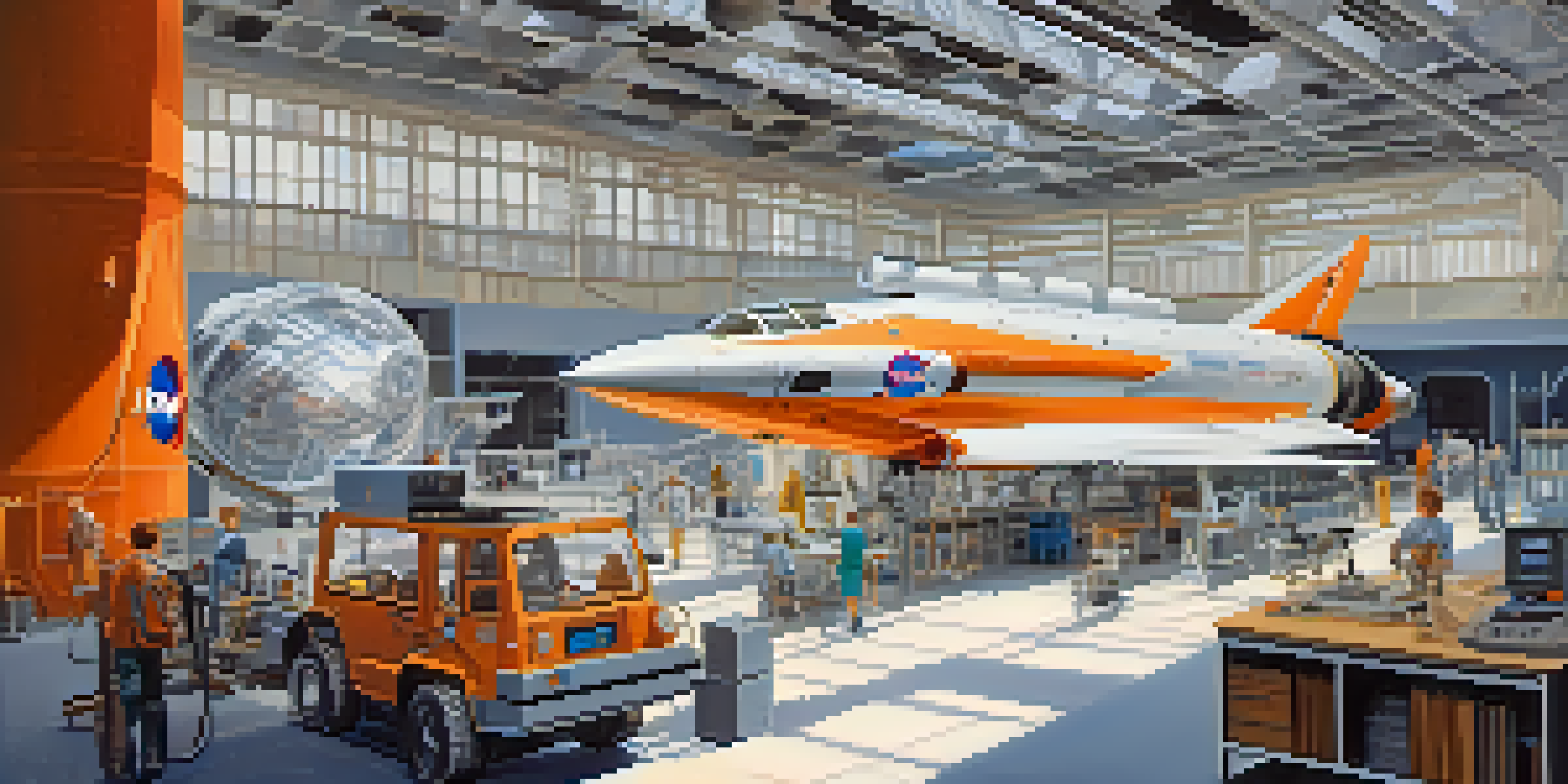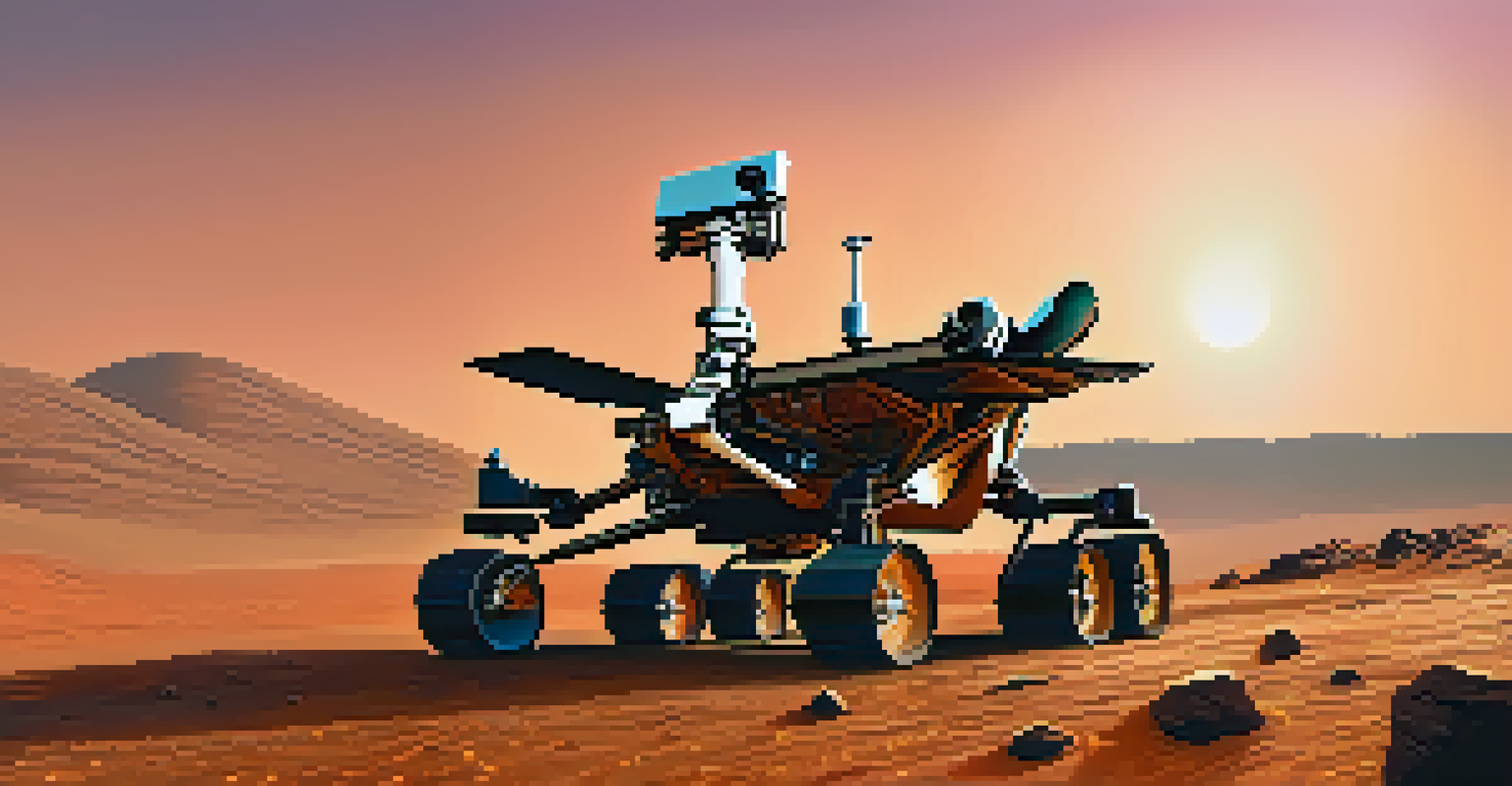California's Contributions to Mars Exploration Missions

The Birthplace of Mars Exploration Technology
California is home to several key organizations that have pioneered technology for Mars exploration. NASA's Jet Propulsion Laboratory (JPL), located in Pasadena, has been at the forefront of developing spacecraft and rovers that have traversed the Martian surface. Their innovative designs and engineering solutions have set the stage for successful missions.
The Earth is the cradle of humanity, but mankind cannot stay in the cradle forever.
For instance, the Mars rovers Spirit and Opportunity, which landed in 2004, were designed and built at JPL. These rovers not only explored the Martian terrain but also provided invaluable data about the planet's geology and climate. Their findings have reshaped our understanding of Mars as a potential habitat for life.
Additionally, California's universities and research institutions contribute to this technological advancement. Collaborations between JPL and institutions like Stanford and Caltech foster an environment where new ideas flourish, directly impacting Mars missions.
Innovative Rovers Developed in California
One of the most significant contributions from California to Mars exploration is the development of rovers. The Curiosity rover, which landed on Mars in 2012, was designed to explore the planet's habitability. Equipped with sophisticated scientific instruments, Curiosity has provided a wealth of information about Mars' atmosphere and surface conditions.

The most recent rover, Perseverance, launched in 2020, continues this legacy of innovation. Also developed at JPL, Perseverance is equipped with advanced technology designed to search for signs of ancient life and collect samples for future return to Earth. Its mission is a testament to California's ongoing commitment to pushing the boundaries of space exploration.
California Leads Mars Tech Development
Key organizations in California, like NASA's JPL, are at the forefront of developing advanced technology for Mars exploration.
These rovers not only enhance our knowledge of Mars but also inspire the next generation of scientists and engineers. By showcasing California's cutting-edge technology, they spark interest and encourage students to pursue careers in STEM fields.
California's Collaborations with Private Space Companies
The state's thriving tech scene has also led to collaborations with private aerospace companies, enhancing Mars exploration efforts. Companies like SpaceX and Planet Labs are pushing the envelope in space technology, which complements NASA's missions. Their innovative approaches and cost-effective solutions are reshaping how we explore Mars.
Space exploration is a force of nature unto itself that no other force in society can rival.
SpaceX, for example, is developing the Starship spacecraft, which aims to transport humans to Mars in the future. This ambitious project, based in California, could significantly accelerate human exploration of the Red Planet. Such collaborations highlight the synergy between government agencies and private enterprises.
These partnerships are not just about technology; they also represent a shift in how we view space exploration as a collective human endeavor. By pooling resources and expertise, California is at the center of this exciting new era of Martian exploration.
The Role of California's Universities in Mars Research
California's universities play a crucial role in advancing our understanding of Mars. Institutions like the University of California, Berkeley, and Stanford University are engaged in cutting-edge research that informs Mars missions. Their work includes studying Martian geology, climate, and potential for past life.
For example, researchers at these universities collaborate with NASA to analyze data collected from Mars missions. This research not only enhances our understanding of Mars but also contributes to the development of future missions and technologies. Such academic partnerships are vital for driving innovation.
Collaborations Enhance Mars Research
Partnerships between California universities, private companies, and NASA foster innovation and drive ambitious Mars missions.
Moreover, these universities often involve students in their research projects, providing hands-on experience that prepares them for careers in space science. This educational aspect ensures that the next generation of scientists is well-equipped to tackle the challenges of exploring Mars.
California's Impact on Global Mars Exploration Initiatives
California's contributions to Mars exploration are not limited to the United States; they have a global impact as well. The state's innovations in technology and research have influenced international space agencies, leading to collaborative efforts in exploring Mars. This global approach fosters a sense of unity in the quest to understand our neighboring planet.
For instance, NASA's Mars missions often involve partnerships with space agencies from around the world, including the European Space Agency (ESA). California's advancements in Mars technology have helped shape these international collaborations, making them more effective and ambitious.
By sharing knowledge and resources, California is playing a pivotal role in uniting global efforts to explore Mars. This collaborative spirit is essential for addressing the complex challenges of space exploration and maximizing our understanding of the universe.
Public Engagement and Outreach Initiatives
California's commitment to Mars exploration extends beyond technology and research; it also involves engaging the public. Organizations like JPL host events, exhibitions, and educational programs to inspire interest in space exploration. These initiatives are crucial for fostering a sense of community and curiosity about Mars.
For example, JPL's Open House events allow visitors to tour the facility and learn about ongoing missions. Such experiences help demystify space exploration and make it accessible to people of all ages. By showcasing their work, California organizations cultivate excitement about Mars missions.
Public Engagement Fuels Interest
California's outreach initiatives, such as events and social media campaigns, inspire public interest and build a community around Mars exploration.
Additionally, social media campaigns and virtual events have expanded the reach of these outreach efforts. By engaging with a global audience, California is not just advancing technology; it's building a community of space enthusiasts passionate about the future of Mars exploration.
Future Prospects for California and Mars Missions
Looking ahead, California's role in Mars exploration is poised to expand even further. With ongoing advancements in technology and research, the state is gearing up for ambitious future missions. This includes plans for human exploration, which could become a reality within the next couple of decades.
Moreover, California's diverse talent pool continues to attract some of the best minds in aerospace and engineering. This influx of creativity and innovation is essential for tackling the challenges that lie ahead in Mars exploration. The future promises exciting developments that could redefine our understanding of the Red Planet.

As we move forward, California's contributions will likely remain at the forefront of Mars exploration. The collaborative spirit, technological ingenuity, and passionate public engagement will ensure that the quest to explore Mars continues to inspire generations to come.